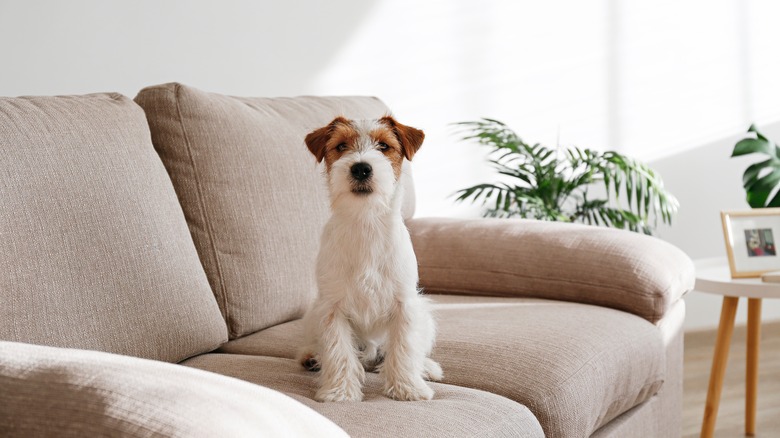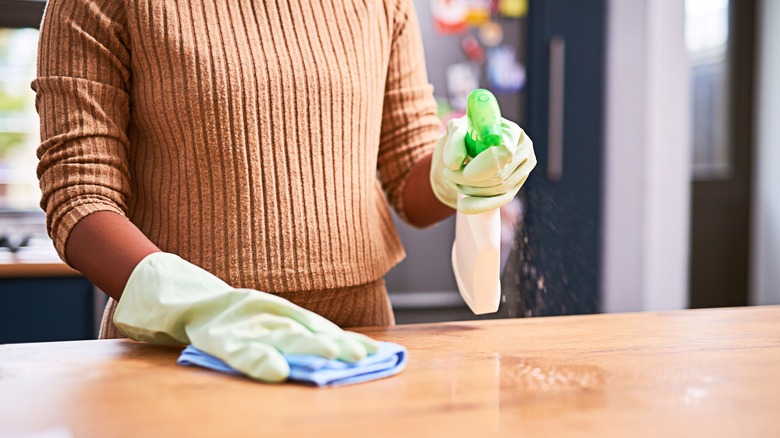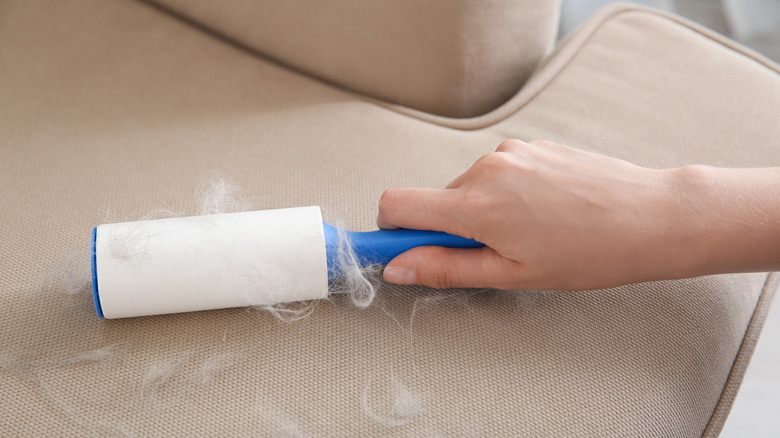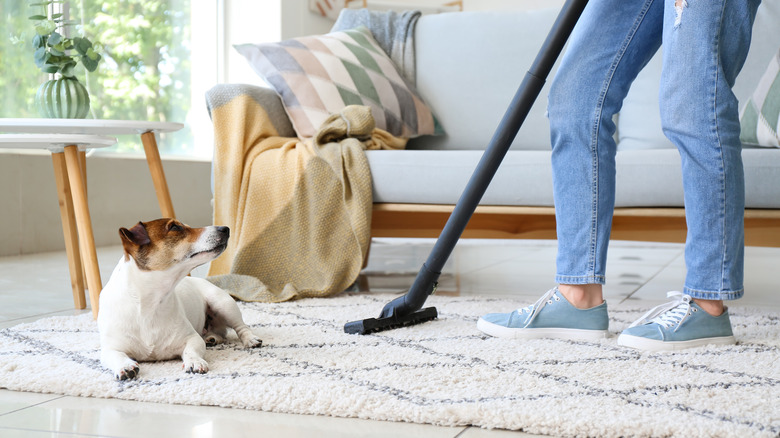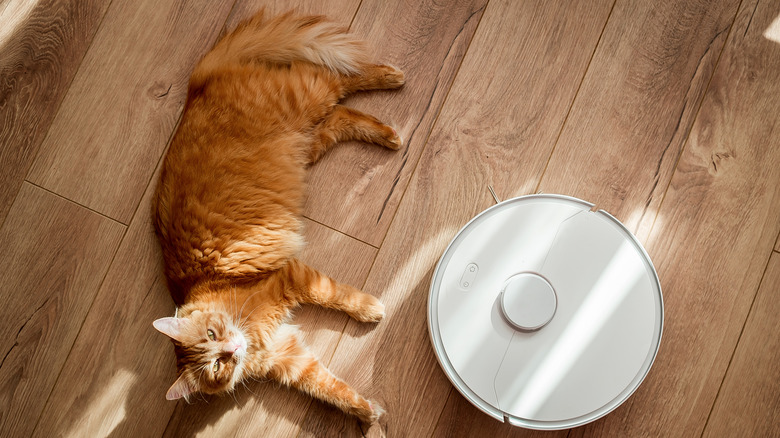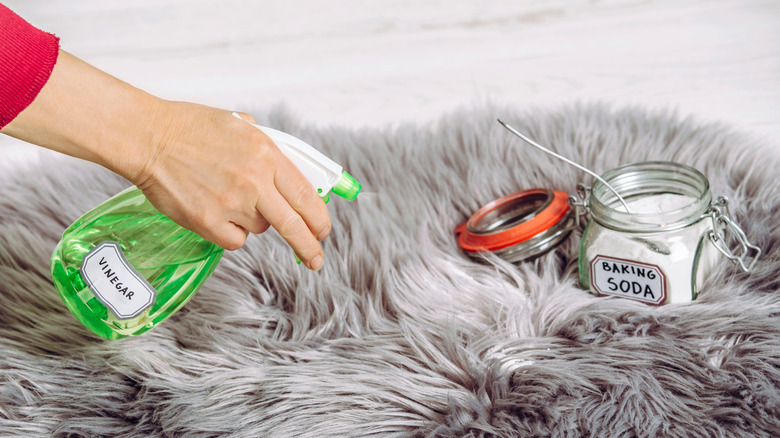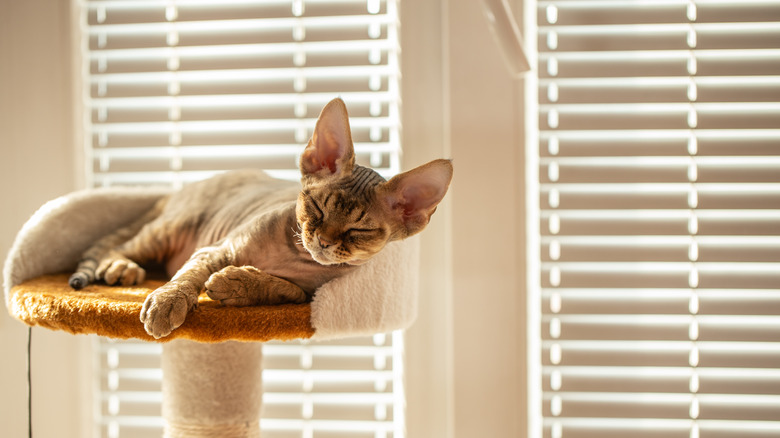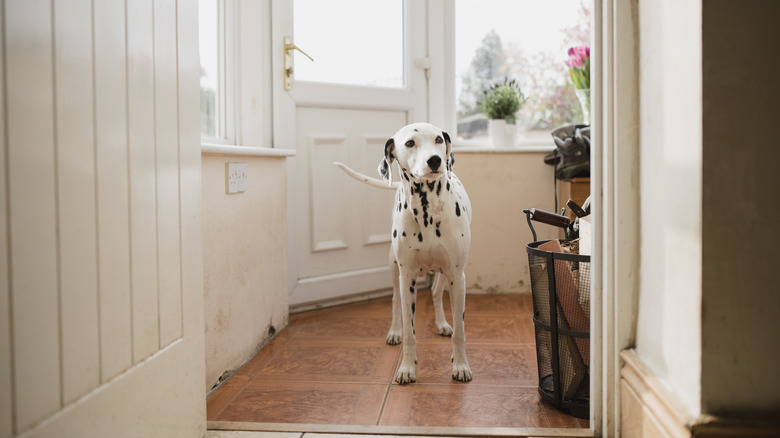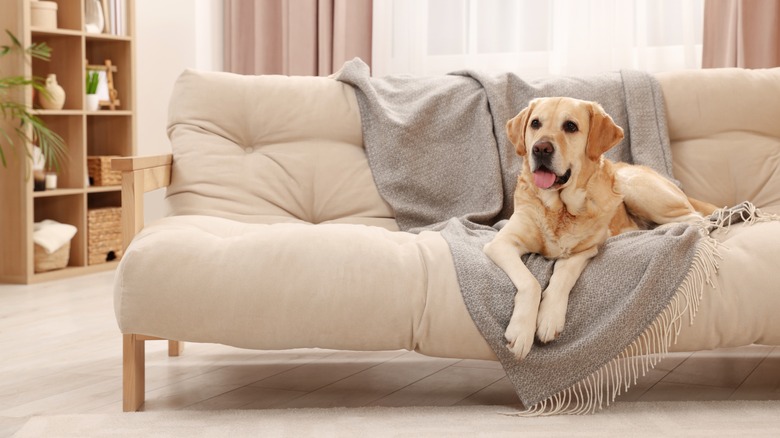House Cleaning Tips Pet Owners Should Live By
We may receive a commission on purchases made from links.
Pets are a beloved member of the family, and many of us can't imagine life without our furry friends. The trade-off? A home with purring cats, scrappy pooches, and other animals can get dirty and smelly pretty quickly. Frequent cleaning is a must for keeping on top of pet messes, and you can make the task even easier with a few tips in mind. From tackling shedding fur to muddy paw prints, we've rounded up some tips that will help you clean more effectively.
To keep up with demand, the market is flush with pet-friendly cleaning products, from specialized stain removers to robotic litter boxes. We've included some helpful products in this guide, but if you're on a budget, we have plenty of tips that utilize what you might already have around the house. Keep your home more tidy, fresh, and pet-friendly with these tried-and-tested home cleaning tips for pet owners.
Use cleaning products that are safe for animals
Many common cleaning products can be dangerous for pets, including those containing bleach, ammonia, isopropyl alcohol, and hydrogen peroxide. It's still possible to use these products around pets — just make sure to always follow the label instructions and store chemicals safely. For example, diluted bleach solutions and many cleaners are safe to use around pets (and recommended by the CDC for disinfecting), as long as you rinse off any residue and let the surface dry before animals have access. But you don't always need to disinfect surfaces, so why not use a safer option for day-to-day? Consider swapping to pet-safe cleaners.
One budget-friendly way to do so is to make your own cleaner. Soap and water is the tried-and-true cleaning solution, but you can also use vinegar and baking soda to freshen up your home. However, just because an ingredient is natural doesn't mean you shouldn't use caution. For example, some essential oils such as tea tree, cinnamon, and citrus oil are toxic to animals, so they're best avoided in your DIY cleaning solutions.
Pet-safe cleaners come ready to use and have effective but safer ingredients for use around pets. They can use plant-based ingredients, enzymes, and surfactants and often skip the fragrances and dyes that can be irritating to both pets and people. For daily cleaning, a product like the CleanSmart Daily Surface Cleaner is a safer, pet-friendly disinfectant that doesn't leave a chemical residue behind.
Use the right tools and products
Many pet messes are of a biological nature, so you'll want to tackle them appropriately. It's not the same as cleaning up your regular dirt and dust! Pet-specific stain and odor removers can be more effective than your usual cleaners for use on animal droppings, urine, and vomit. They often have enzymatic ingredients to break down organic matter and actually clear them away rather than just cover up the smell. There are general enzymatic cleaners, like Nature's Miracle Stain and Odor Remover, or more specialized formulas, like the Urine Destroyer by the same brand.
A good vacuum is a must-have for any shedding pet, but there are some other tools you can add to your arsenal for easier cleaning. An air purifier can help scrub the air around the clock, reducing pet dander and smells in the air. If you have thick carpets, a tool like the FURemover Pet Hair Rubber Broom can lift fur that a vacuum missed. The Uproot Cleaner Pro Pet Hair Remover is a similar product for smaller surfaces, like couches and pet beds, while the mini Lilly Brush is suited for removing pet hair from small nooks and crannies. Lint rollers are also a useful item for cleaning up fur (use them on surfaces as well as your clothes). A larger version like the Chom Chom Roller can help clean more hair in one pass from the couch or bed. In short, it's worth investing in some tools that will make your cleaning process easier and more effective.
Clean your home frequently to stay on top of hair and dander
Frequent cleaning is the best way to reduce pet messes and odors in your home. Stick to a schedule to make sure tasks aren't missed. A small amount of daily tidying can really help you stay on top of cleaning. A good habit to get into is a 15-minute daily clean-up routine. Choose a room and arm yourself with a basket, vacuum, duster, and all-purpose cleaner. Set a 15-minute timer, then start with clearing clutter by putting it into the basket (don't bother returning each item to its home yet — it wastes cleaning time. You can put items away after the 15 minutes is up, or during a larger weekly clean). Do a quick run-through with the vacuum and duster to pick up noticeable patches of pet hair and dust. Wipe down frequently used surfaces with an all-purpose cleaner to clean up germs and grime. The key here is to do a general quick clean; save the deep cleaning for later. There are two spots you don't want to miss: Pet bowls and litter boxes should be cleaned daily to prevent bacteria and odors.
On top of a daily quick clean, many cleaning experts recommend a bigger deep clean once a week, where you'll want to vacuum, mop, wipe down and disinfect surfaces. You'll also want to change the sheets, wash pet bedding, and clean any other covers (such as blankets if pets spend lots of time on the bed or couch). At least once a month, take the time to wash pet clothing, toys, and other accessories, including emptying and cleaning food and treat containers.
Automate cleaning your pet items
Cleaning up after pets can be a hassle, but nowadays, you don't need to handle every task by yourself. There are plenty of helpers that can take some of the load off, from taking advantage of your dishwasher to using automated robot vacuums. After all, the more convenient it feels to clean, the more likely you are to do it. Robot vacuums can clear pet hair from hard floors and carpets, and while they won't replace a deep clean with a full-size vacuum, they will help you stay on top of daily messes. A model like the iRobot Roomba i3+ EVO (3550) Robot Vacuum even has a self-emptying feature, which reduces how often you need to dump out the bin. Some products do even more pet-specific tasks. For example, if you have a cat, you might want to consider the Litter-Robot 3, a self-cleaning robotic litter box that takes care of this messy job for you.
These top-of-the-line accessories can be expensive, but there are things you can consider if you're on a budget. They'll take a bit more effort from you, but can still cut your cleaning time. An alternative to a robot litter box is a sifting litter box, like the Petmate Large Sifting Litter Box, which some cat owners find easier to clean compared to using a scoop. You should also always check accessories for cleaning directions. Some items can be thrown in the dishwasher, washing machine, or dryer, and you should take advantage of this easier cleaning process when you can. To stay on top of cleaning, you can also try to automate your own habits by attaching a pet cleaning task with your everyday cleaning tasks. For example, you can wash your pet's bowls whenever you run the dishwasher at the end of the day.
A deodorizing routine can keep pet smells at bay
If you have an extra stinky pooch (or you're just worried you've become accustomed to your pet's smell), a deodorizing routine can help keep your home extra fresh. You can tackle some odors at the source. Deodorizing wipes like the Wet Ones Deodorizing Multi-Purpose Wipes can help keep Fido fresh until the next bath day. If you have a cat, a litter box odor eliminator can help reduce smells. Much like a modern diaper pail, a dedicated litter pail (the Litter Genie Standard Pail is a highly-rated pick) can keep smells contained.
When it comes to reducing general pet smells, the first (and easiest) step is to air out the house as often as you can by opening up windows. When that's not possible, take advantage of the odor-busting powers of vinegar and baking soda. A diluted vinegar spray can be used on most surfaces. While it will smell like vinegar at first, the smell should dissipate once it's dried. You can also cover stinky surfaces like pet beds or their favorite spot on the couch with baking soda. Let the baking soda sit for a few minutes, then remove it by sweeping most of it up and then vacuuming up the leftover residue (vacuuming large amounts of baking soda can harm your machine).
Create pet areas and use accessories to keep them clean
If you keep your pet contained to certain areas, this can also help contain their mess. Consider keeping pets out of carpeted rooms and off soft furniture, both of which are harder to clean and can absorb odors more than hard surfaces. Even better, give your pets their own furniture and accessories, particularly dishwasher- and machine-washable items. Pet beds, scratching posts, and toys can keep pets occupied and in their own space, which can also help you protect your living areas.
You can keep pet areas cleaner with a range of accessories, ranging from basic to pet-specific. A simple bin is useful for tossing pet toys, clothing, and accessories into for a quick cleanup. A rubber mat like the Gorilla Grip Silicone Pet Feeding Mat is great for under pet bowls. Similarly, the Gorilla Grip Cat Litter Box can trap stray litter as cats leave the litter box. It's all about keeping messes in their place!
A pet cleaning station can help stop dirt and clutter at the door
Muddy paw prints and scattered foliage don't need to be a household problem if you have the right entryway setup. Create a cleaning station near your front door to wipe fur and feet and prevent tracking dirt into the house — for dogs and even cats (if you can catch them when they come in). Your entryway area should have space to store pet items that commonly go in and out of the home (for example, dog leashes, collars, and doggy poop bags). An absorbent and soft microfiber doormat can help catch moisture and gently clean paws as pets make their way inside. Though it's marketed for pups, the Dog Gone Smart Dirty Dog Microfiber Paw Doormat is soft underfoot for cats as well.
Dog paw washers like the Dexas MudBuster Portable Paw Cleaner are useful for scrubbing dog paws after particularly muddy romps. The portable cup will give paws a more thorough clean than a mat without needing to resort to the bath. Smaller messes can be cleaned with a wet wipe designed for pets, like this one from Wet Ones which is formulated to be animal-safe. Dirty paws are just one part of the equation; pets can also track dirt, leaves, and other debris indoors on their fur. Keep a brush or grooming glove near the front entryway, which you can use to quickly brush bits off your pet's fur. A handy silicone grooming glove like the Petmate 89801 Furbuster 3-in-1 will capture debris (and get rid of some loose fur as well).
Cover your living areas with washable covers, throws, and rugs
Almost any cat owner knows how hard it is to keep kitties off the furniture, and this rings true for some dog owners as well. Or, if you just love to sleep with your pets or cuddle them while you watch a movie, they might be a welcome addition to your bed or couch. The best way to protect these surfaces and reduce their odor is to use washable covers. A washing machine will do a faster and better job at deodorizing than many upholstery cleaning products.
For your bed, start with waterproof mattress and pillow protectors, which will protect you from liquid messes, and then use washable bedding and blankets on top. If you have a fabric couch, one with washable covers will be easiest to clean, but leather and artificial leather also aren't bad choices since they won't absorb liquids or hold onto fur. If both of these options are out of the question, or you just want some extra protection, cover your furniture in decorative throw blankets. They'll make your space look cozier and provide that extra bit of coverage in case of accidents. Some brands even make throws with pets in mind, such as this thick, stylish Pet Throw from Pottery Barn.
To protect hard floors and even carpets, consider adding washable rugs to your space. Layered area rugs can look particularly stylish and offer extra protection to your floors. If your pet is prone to accidents and you don't want to launder your rugs weekly, consider using an indoor/outdoor rug, which is generally easier to clean than indoor-only counterparts.
